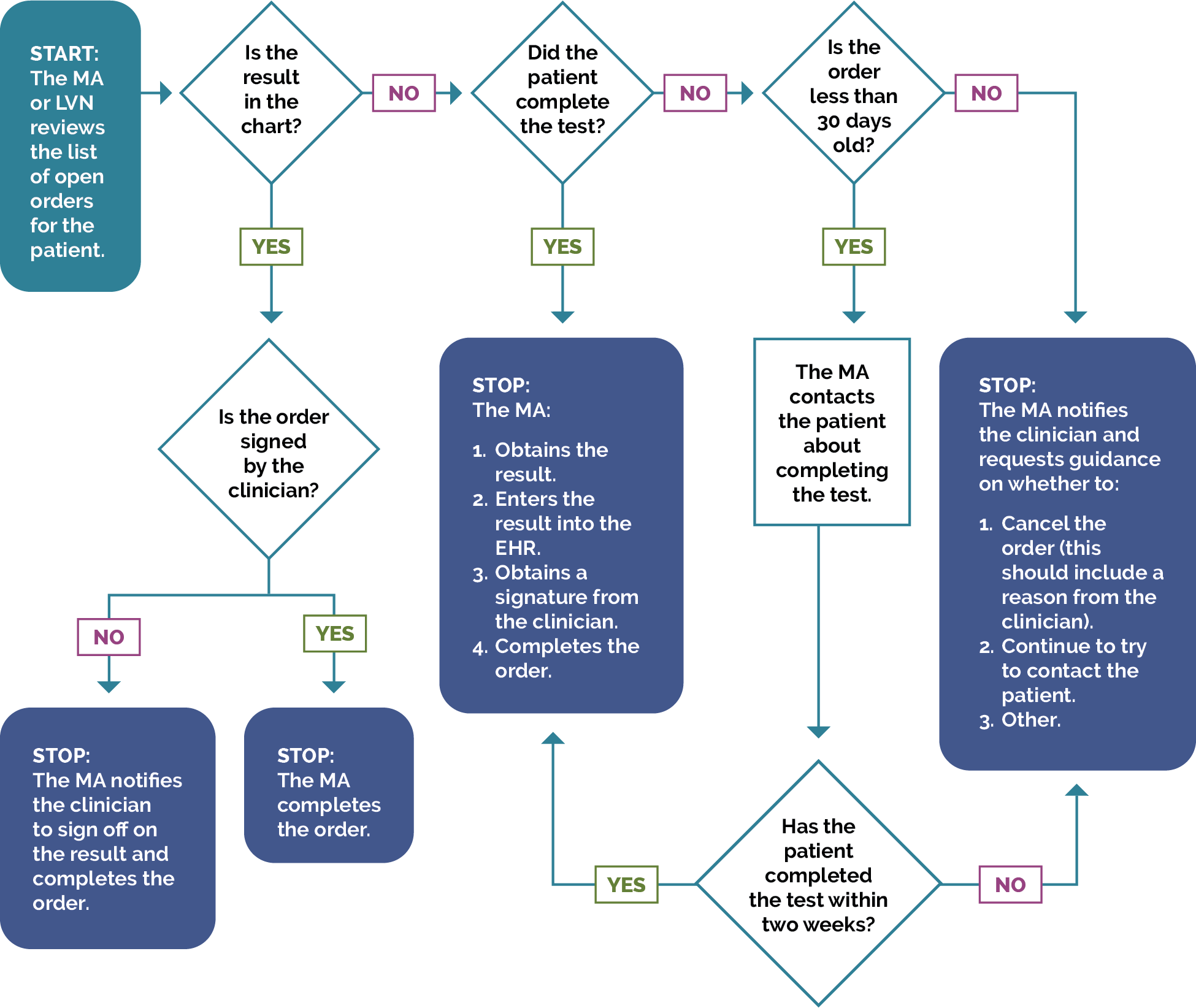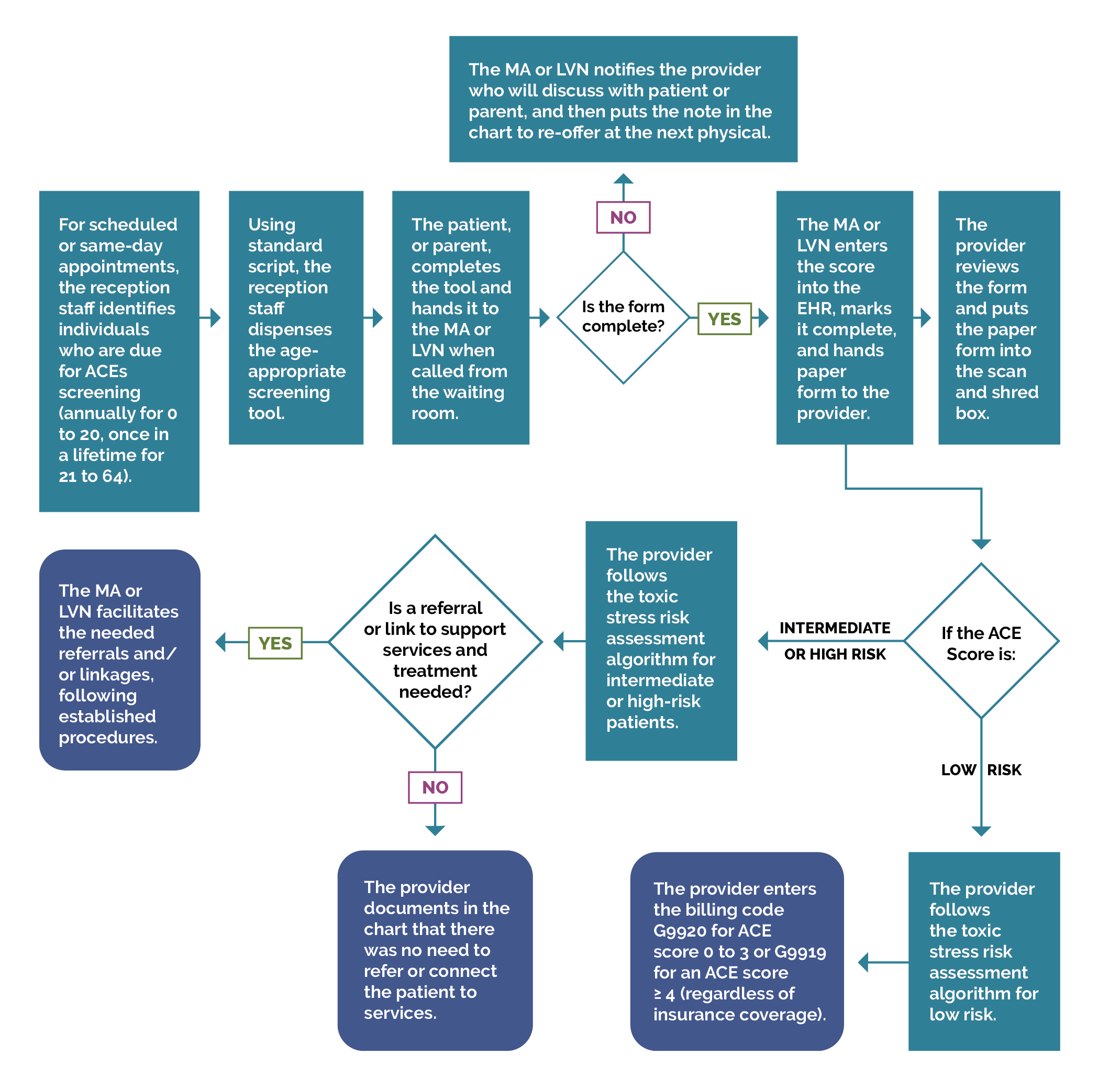KEY ACTIVITY #5:
Develop or Refine and Implement a Pre-Visit Planning Process
This key activity involves all seven elements of person-centered population-based care: operationalize clinical guidelines; pre-visit planning and care gap reduction; care coordination; address social needs.
Overview
This key activity provides guidance for how the care team can effectively and efficiently embed preventive care measures into the practice’s pre-visit planning process (PVP). Pre-visit planning is typically driven by the medical assistant with help from other care team members and includes steps taken:
- At the end of the current visit to ensure the patient understands any actions they need to take and to schedule for any follow-up.
- Prior to a scheduled appointment, to scrub the chart and identify any pre-visit tasks per the pre-visit checklist.
- The day of an appointment, during the daily huddle and before the patient sees the PCP.
Approximately 80% of pediatric visits last 20 minutes or less,[1] and many patients come to these visits with multiple needs. Pre-visit planning works towards optimizing a team-based approach outside of these short primary care visits so patients receive comprehensive care in alignment with the latest clinical guidelines and their own preferences.
Pre-visit planning allows for better coordination of care. This can be particularly beneficial for patients with complex health needs, ensuring they receive comprehensive and equitable care. As your practice works to reduce any identified equity gaps, pre-visit planning is often a powerful activity for ensuring culturally relevant care as the care team partners with the patient to discuss follow-up actions.
The PVP should incorporate your practice’s process for screening and responding to social needs, including checking whether social needs screening is due. When social needs are identified the team should be clear on the pathways, both during and after visits, to address and follow up on those needs.
Pre-visit planning draws upon similar technical enablers as care gap reporting, and likewise can be facilitated at the individual patient level and at the level of groups of patients coming for care by a specific team in an appointment schedule block. The format in which planning is done needs to consider the workflow and staffing model.
Relevant HIT capabilities to support this activity include electronic access to care guidelines, registries, clinical decision support, care dashboards and reports, outreach and engagement, and care management and care coordination. See Appendix D: Guidance on Technological Interventions.
Individual patient-level pre-visit planning would optimally be enabled within the EHR, provided the EHR is able to store relevant information, such as assessments, plans, orders and notes outside of a visit note. Pre-visit planning might also include use of patient-facing applications, such as portal reminders, questionnaires and self-completed screenings and assessments, which ideally would be available to the clinician and care team in the EHR.
Engagement of the expanded care team in pre-visit planning requires access by all relevant members of the care team to contribute to and view relevant information. This may require coordination with technology additional to the EHR, such as care coordination and population management applications where relevant information might be stored.
Huddle reports, in which individual patient information can be visualized in summary views across all patients within a session, can require use of technology outside the EHR, but might also be supported by developing reports populated by data from the EHR. Ideally, internal practice and EHR data should be supplemented with external data where such information completes the patient’s current status. If such electronic access is not possible, workflow should include manual reconciliation by history from the patient.
Action steps and roles
1. Assess the current state of the pre-visit planning (PVP) process across your practice.
Suggested team member(s) responsible: Implementation team or QI team.
Understand how the process currently works, for all visit types (e.g., scheduled, same-day, virtual), in light of your practice’s performance on core and supplemental measures.
Compile existing paperwork and process documentation about each visit type into one place and talk to medical assistants and other members of the care team to understand their questions and challenges around the pre-visit planning process.
Consider making current-state process maps for each visit type that communicate the major steps in the PVP process and acknowledge pain points or kinks in the process. Pain points are places where the process isn’t working well for patients, staff, or specific subpopulations or demographic groups for which your data analysis has revealed equity gaps. These pain points also likely differ by visit type. In addition, pay attention to places where staff are creating workarounds to the process. The presence of workarounds indicate that the process might need further clarification or refinement to support the care team to reliably implement it.
Your team may find it helpful to compile process maps for both the high-level pre-visit planning, as detailed in figure 6.1 of the PHMI Care Teams and Workforce Guide Resource 6: Workflow Examples, in addition to more detailed documentation for specific clinical workflows.
2. Identify where to update the PVP process to more consistently and reliably address care gaps.
Suggested team member(s) responsible: Implementation team or QI team; may include the data manager to assist with identifying patients through EHRs.
Examine where you can further incorporate or streamline your practice’s clinical protocols and standing orders into PVP, including via the PVP checklist, daily huddles, and other key clinical workflows.
This may include the following discussion points:
- Who will initiate the discussion with the patient based on the needs (e.g., primary language) and preferences of the patient.
- How and when they will plan to have the discussion during the visit.
- How they will be prepared to address any barriers.
- Educational materials available for use that are relevant to the patient.
Examples and considerations for updating the PVP process are included below.
Clinical guidelines and care gaps: Consider which preventive and maintenance services could be addressed more reliably using PVP, including those in your EHR’s care gap module. The Pre-Visit Planning: Leveraging the Team to Identify and Address Gaps in Care resource provides a more complete list of preventive services for adults and children. Figure 10 provides an example of how your EHR might be able to support flagging patients overdue for specific preventive services
FIGURE 10: PRE-VISIT PLANNING REPORT DETAILING OVERDUE SERVICES FOR AN ADOLESCENT

PVP checklist: A generic PVP checklist to be completed by the medical assistant (MA) or LVN at least one to three days before the appointment is provided in Figure 11. Most EHRs will have a health maintenance module that identifies what preventive care is due, but a printed or digital checklist provides a starting point for ensuring key steps aren’t missed.
FIGURE 11. PVP PLANNING CHECKLIST ITEMS TO ADD FOR PEDIATRICS
Checklist Domain |
Checklist Item |
|---|---|
General |
|
Room readiness |
|
Medical record review |
|
Assessments Needed |
|
Care Gaps |
|
Chart scrub: An example chart scrub process led by the MA or LVN as part of PVP for completing open orders is detailed in Figure 12.
FIGURE 12: EXAMPLE CHART SCRUB PROCESS FOR OPEN ORDERS

Daily huddles: Design or redesign the team’s daily huddle so the care team can review prioritized action items for the list of patients scheduled to come and any further follow-up for patients seen in the previous days. For more information, see Care Team Daily Huddle Process.
The Centers for Excellence in Primary Care resource on Healthy Huddles includes tools, a video, and examples around how pre-visit planning flows into the daily huddle process, including a “Healthy Huddles Warm-Up,” which can help MAs prepare for huddles.
Patients requiring special considerations: Ensure that the PVP includes a process to flag for the care team:
- Patients requiring special attention, such as those with chronic conditions, complex needs, and recent ED visits or hospitalizations, or who are in foster care.
- Patients who need extended time or additional services during their visit (e.g., multiple vaccinations needed, translation services, mobility assistance, and screenings).
Detailed clinical workflows: Clinical workflows should be updated to describe at which step in the PVP or the patient visit a care team member will address a specific gap in care with the patient.
FIGURE 13: EXAMPLE WORKFLOW FOR SCREENING FOR ADVERSE CHILDHOOD EXPERIENCES

This example workflow for ACEs screening depends on reception staff and MAs and LVNs as core team members for ensuring the patient gets screened when they are in-office and facilitating referrals afterwards.
Planning for care after the visit: Effective PVP includes scheduling pre-visit labs and other diagnostics at the end of the current visit and care coordination for referrals for services not available at the practice. See Key Activity 11: Coordinate Care for more information. Confirm that the patient understands the purpose of any follow-up care. Ensure that the appropriate after-visit summary has been provided at the conclusion of the visit.
Example: Marin Community Clinics has their hospital-based Comprehensive Perinatal Services Program (CPSP) workers schedule both the newborn visit and three-week appointment with the PCP before the birthing person and baby are discharged from the hospital. Medical assistants have been trained to recognize this workflow to avoid confusion that could lead to mistakenly canceling the three-week appointment. If the newborn visit is kept, subsequent appointments are scheduled before the patient checks out. If the appointment is missed, medical assistants follow a missed appointment workflow. The encounter is labeled as “Well-Check No-Show” and categorized as high-risk.
Tip: The American Medical Association (AMA) has an online guide for implementing pre-visit planning, which includes forms, templates and other resources. Limited published literature on the effectiveness of pre-visit planning in the pediatric setting exists, however Samaan, et al. published this study in Pediatrics in 2016: Implementation of a preventive services bundle in academic pediatric primary care centers.
3. Test planned changes to the PVP workflows and support care teams in implementing the workflow.
Suggested team member(s) responsible: Implementation team or QI team.
Test and refine important changes to the PVP process with one or two care teams before considering rolling out the change more broadly at the practice.
Implementing the change includes updating documentation and creating a staff training schedule or “training refresher” for staff to sustain workflow changes. For example, train MA's every 6 months on the PVP. If they have difficulty, have them retake training with a different highly effective MA and monitor closely until competency in the task is reached.
Tip: Develop staff training and talking points on how to communicate about the importance of vaccinations. See more in Key Activity 9A: Providing Caregiver Support to Overcome Vaccine Hesitancy.
4. Establish a process to review and update PVP workflow.
Suggested team member(s) responsible: Care team with quality improvement manager.
Identify staff responsible for reviewing and updating the PVP process at least annually to incorporate the latest clinical guidelines and check for any workarounds that have developed.